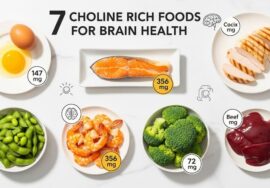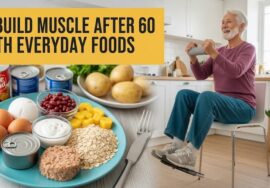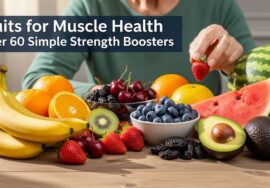Tiny as a grain of pepper, but packing the kind of nutrition most “superfoods” only dream about — that’s chia. For adults 60 and over, these little seeds hit three big wellness targets at once: calcium to protect aging bones, plant-based omega-3s to help the heart and brain, and powerful antioxidants to fight the daily wear and tear of inflammation. “Tiny but Mighty: Chia’s Calcium, Omega-3, and Antioxidants Fuel 60+ Wellness” shows how a spoonful a day can quietly support stronger bones, steadier energy, and healthier aging — without complicated recipes or expensive supplements.

Table of Contents
- Quick Answers
- Why chia works for seniors: nutrient snapshot
- Bone support after 60: plant-calcium from chia (serving size, absorption, food pairing)
- Brain & heart support after 60: ALA omega-3 from chia (vs EPA/DHA)
- Antioxidant support for healthy aging: chia polyphenols & gentle anti-inflammatory eating
- Safety notes for older adults (hydration, meds, oxalates)
- Senior-easy meal ideas: “soak-first” chia playbook
- A real celebrity anecdote that popularized chia (and what matters for 60+)
- FAQ
- Sources & further reading
1) Quick Answers
- What is it? Chia is a tiny seed rich in calcium, ALA omega-3, fiber, and antioxidants—nutrients useful for bone, heart/brain, and digestive health in older adults. The Nutrition Source

- Why it helps 60+? One ounce (~2 Tbsp) supplies ~18% DV calcium plus ALA omega-3 and 11 g fiber, supporting bone strength, heart/brain function, and regularity. The Nutrition Source

- Daily idea: Start with 1–2 Tbsp soaked in yogurt or oatmeal; increase slowly with fluids to avoid GI discomfort. EatingWell

- Omega-3 nuance: Chia provides ALA (plant omega-3). You still need seafood (EPA/DHA) weekly if your clinician agrees. www.heart.org+2Office of Dietary Supplements+2

2) Why chia works for seniors: nutrient snapshot
Two tablespoons (~28 g) of chia provide ~140 kcal, ~11 g fiber, plant omega-3 (ALA), and meaningful calcium, magnesium, and phosphorus—nutrients linked with bone and cardiovascular support. The Nutrition Source
For label-style specifics, MyFoodData (USDA-based) estimates ~179 mg calcium per ounce (varies by source), with notable potassium and phosphorus. My Food Data

Helpful lens for 60+: small, daily amounts of nutrient-dense foods add up—especially when they’re easy to prep and gentle to chew.
3) Bone support after 60: plant-calcium from chia
- RDA context (USA): Women 51+ generally 1,200 mg/day; men 51–70 1,000 mg/day; men 71+ 1,200 mg/day. Food first; supplements only if needed. Office of Dietary Supplements

- Where chia fits: ~179 mg calcium/oz makes chia a useful add-on (not a sole source). Combine with dairy/fortified milks, tofu, greens, or canned salmon with bones. My Food Data

- Absorption tips: Pair calcium foods with vitamin D sources (fatty fish, fortified milk) and adequate protein; keep fiber/hydration balanced. Office of Dietary Supplements

- Reality check: Headlines like “more calcium than milk” can be true by weight, but typical portions differ. Focus on total daily intake from varied foods. Harvard Health

4) Brain & heart support after 60: ALA omega-3 from chia (vs EPA/DHA)
- What chia gives: ALA—the plant form of omega-3—supports heart health patterns; the body converts a small amount to EPA/DHA. Office of Dietary Supplements

- What fish gives: EPA/DHA directly; the AHA still recommends 2 seafood meals/week for heart protection (when appropriate for you). www.heart.org+1

- Balanced approach: Use chia daily for fiber/ALA; include seafood weekly unless your clinician advises otherwise. www.heart.org

5) Antioxidant support for healthy aging: chia polyphenols & gentle anti-inflammatory eating
Chia provides antioxidants and polyphenols alongside fiber and healthy fats—factors linked with lower oxidative stress and supportive aging patterns. Practical win: chia’s gel-forming fiber may help you build less sugary, more satiating breakfasts. Cleveland Clinic

6) Safety notes for older adults (hydration, meds, oxalates)
- Hydrate/soak: Always soak or mix chia and sip fluids to avoid bloating or choking risk. Start with 1 Tbsp/day and build slowly. EatingWell

- Meds & conditions: High-fiber, omega-3-rich foods may interact with blood thinners or affect blood sugar/pressure—check with your clinician. EatingWell

- Oxalates: If you have a history of oxalate kidney stones, moderate portions and review with your care team. EatingWell

7) Senior-easy meal ideas: the “soak-first” chia playbook
- Overnight chia-yogurt cup: 1–2 Tbsp chia + ¾ cup Greek yogurt + berries; rest 15–30 minutes or overnight.

- Warm oat-chia bowl: Stir 1 Tbsp chia into cooked oats; finish with walnuts and cinnamon.

- Cottage-chia fruit bowl: ½ cup cottage cheese + 1 Tbsp chia + pineapple tidbits.

(These combinations naturally pair calcium + protein + fiber, making them senior-friendly and satiating.)
8) A real celebrity anecdote that popularized chia (and what matters for 60+)
Supermodel Miranda Kerr mentioned adding chia seeds to her daily smoothie in a Vogue interview years ago—one of many pop-culture moments that brought chia into mainstream kitchens. The takeaway for 60+: trends aside, the habit (small, daily, soaked portions) is what consistently helps older adults reach nutrient goals. Vogue Australia

9) FAQ
Q1. How much chia should a 60+ adult start with?
Start with 1 Tbsp/day, soaked, plus fluids; increase to 2 Tbsp as tolerated. EatingWell
Q2. Does chia replace calcium supplements?
No. It’s a food contributor to your daily calcium target. Discuss supplements with your clinician based on your RDA and diet. Office of Dietary Supplements
Q3. Is chia’s omega-3 the same as fish oil?
Chia provides ALA (plant omega-3). Fish provide EPA/DHA; AHA still recommends fish twice weekly for heart health. www.heart.org+1
Q4. What’s a “gentle” way to eat chia with dentures?
Soak first (pudding/oats/yogurt). The gel texture is soft and easy to chew.
Q5. Can I use chia if I’m on a blood thinner?
Possibly, but review with your clinician due to omega-3/fiber interactions. EatingWell
Q6. Does chia help with regularity?
Yes—soluble + insoluble fiber can support bowel regularity; increase slowly and hydrate. The Nutrition Source
Q7. Is “more calcium than milk” accurate?
By weight, chia can be higher; by common portions, results vary. Aim for total daily calcium from varied foods. Harvard Health
Q8. What are good pairings for absorption?
Combine calcium foods with vitamin D sources (fortified milk, fish); keep protein adequate. Office of Dietary Supplements
Q9. Any issue with kidney stones?
If you form oxalate stones, moderate chia and confirm with your clinician. EatingWell
Q10. Is there a “best” time to eat chia?
Morning works well for satiety and regularity, but consistency matters more than timing.
10) Sources & further reading (authoritative outbound links)
- Harvard T.H. Chan – The Nutrition Source (Chia Seeds): Read overview. The Nutrition Source
- Harvard Health – Chia seed benefits (2024): What you need to know. Harvard Health
- NIH Office of Dietary Supplements – Calcium (Health Professional): RDA & guidance. Office of Dietary Supplements
- American Heart Association – Are you getting enough omega-3s?: ALA vs EPA/DHA. www.heart.org
- Mayo Clinic – Omega-3 in fish & heart health: Why 2 fish meals/week. Mayo Clinic
- Cleveland Clinic – Benefits of chia seeds (2025 update): Evidence-informed guide. Cleveland Clinic
- USDA/MyFoodData (chia facts): Label-style nutrients. My Food Data
- Vogue – Miranda Kerr’s chia smoothie mention: Lifestyle interview. Vogue Australia
- EatingWell – Chia side effects & cautions: Dietitian guidance. EatingWell








